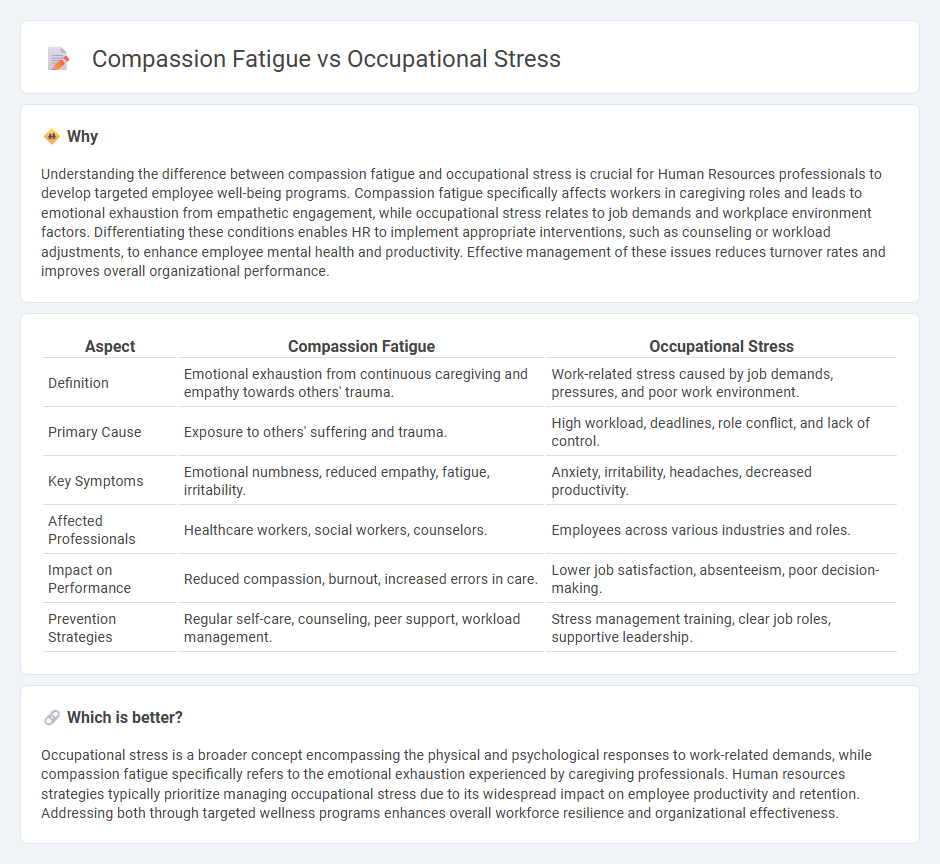
Compassion fatigue and occupational stress are critical challenges in human resources, affecting employee well-being and organizational productivity. Compassion fatigue arises from prolonged exposure to others' suffering, leading to emotional exhaustion, while occupational stress results from job-related pressures and demands. Explore effective strategies to recognize, manage, and mitigate these impacts for a healthier workforce.
Why it is important
Understanding the difference between compassion fatigue and occupational stress is crucial for Human Resources professionals to develop targeted employee well-being programs. Compassion fatigue specifically affects workers in caregiving roles and leads to emotional exhaustion from empathetic engagement, while occupational stress relates to job demands and workplace environment factors. Differentiating these conditions enables HR to implement appropriate interventions, such as counseling or workload adjustments, to enhance employee mental health and productivity. Effective management of these issues reduces turnover rates and improves overall organizational performance.
Comparison Table
| Aspect | Compassion Fatigue | Occupational Stress |
|---|---|---|
| Definition | Emotional exhaustion from continuous caregiving and empathy towards others' trauma. | Work-related stress caused by job demands, pressures, and poor work environment. |
| Primary Cause | Exposure to others' suffering and trauma. | High workload, deadlines, role conflict, and lack of control. |
| Key Symptoms | Emotional numbness, reduced empathy, fatigue, irritability. | Anxiety, irritability, headaches, decreased productivity. |
| Affected Professionals | Healthcare workers, social workers, counselors. | Employees across various industries and roles. |
| Impact on Performance | Reduced compassion, burnout, increased errors in care. | Lower job satisfaction, absenteeism, poor decision-making. |
| Prevention Strategies | Regular self-care, counseling, peer support, workload management. | Stress management training, clear job roles, supportive leadership. |
Which is better?
Occupational stress is a broader concept encompassing the physical and psychological responses to work-related demands, while compassion fatigue specifically refers to the emotional exhaustion experienced by caregiving professionals. Human resources strategies typically prioritize managing occupational stress due to its widespread impact on employee productivity and retention. Addressing both through targeted wellness programs enhances overall workforce resilience and organizational effectiveness.
Connection
Compassion fatigue and occupational stress are interconnected through their impact on emotional exhaustion and decreased job performance in human resources professionals. Prolonged exposure to employee conflicts and high workloads amplifies stress levels, leading to compassion fatigue characterized by reduced empathy and increased burnout. Addressing both conditions through targeted support programs enhances workforce resilience and maintains effective HR management.
Key Terms
**Occupational Stress:**
Occupational stress refers to the chronic strain experienced by employees due to job demands, role ambiguity, and workplace environment, often resulting in anxiety, burnout, and decreased productivity. Unlike compassion fatigue, which stems from prolonged exposure to patients' suffering or emotional demands, occupational stress encompasses broader factors such as workload, organizational culture, and work-life imbalance. Explore further insights on managing occupational stress effectively to foster a healthier work environment.
Job Demands
Occupational stress primarily results from excessive job demands such as high workload, tight deadlines, and role ambiguity, which strain an employee's physical and mental resources. Compassion fatigue stems specifically from continuous exposure to others' suffering and emotional demands, often seen in caregiving professions, leading to emotional exhaustion and reduced empathy. Explore further to understand how managing job demands can mitigate both occupational stress and compassion fatigue effectively.
Burnout
Occupational stress stems from ongoing work demands and pressures, leading to chronic tension and decreased job satisfaction, while compassion fatigue arises from the emotional strain of caring for others, often resulting in deep exhaustion and reduced empathy. Burnout manifests as a state of emotional, physical, and mental exhaustion caused by prolonged occupational stress and compassion fatigue, characterized by feelings of helplessness, cynicism, and detachment from work. Explore further to understand effective strategies for managing burnout and promoting workplace well-being.
Source and External Links
Occupational Stress - Occupational stress refers to psychological stress related to one's job, often resulting from lack of support, control, or proportionate rewards for efforts, impacting both emotional well-being and physical health.
Managing Occupational Stress - This resource outlines common symptoms of occupational stress, such as burnout and anxiety, and emphasizes the importance of early intervention to mitigate negative effects on employees.
Workplace Stress - Workplace stress impacts employees' physical and mental health, potentially leading to conditions like heart disease, anxiety, and depression, while also affecting job performance and employer interests.
 dowidth.com
dowidth.com